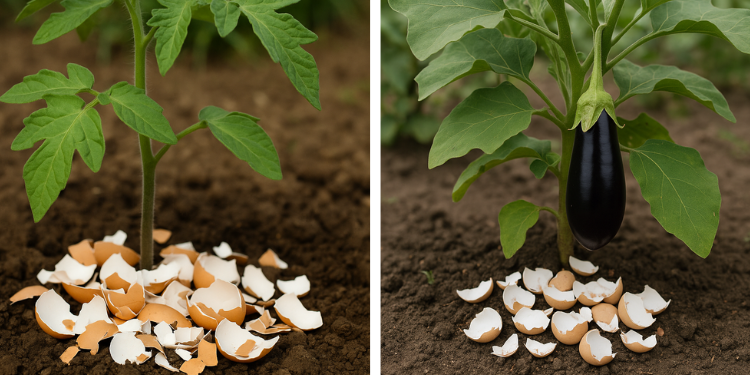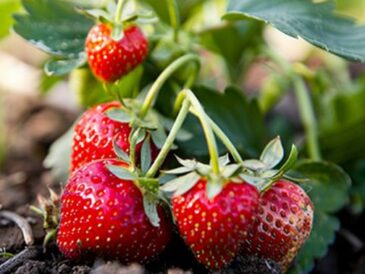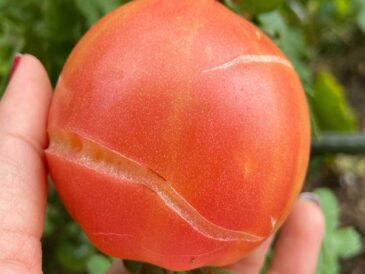If you’re in the habit of tossing out your breakfast eggshells, you might be throwing away one of the most valuable natural fertilizers your garden could ever get.
Eggshells are rich in calcium carbonate, the same compound found in agricultural lime – a key nutrient that helps plants build strong cell walls, prevent blossom-end rot, and support vigorous root growth.
Why Eggshells Are So Good for Plants
Eggshells are made up of about 95% calcium carbonate, along with small amounts of magnesium, potassium, and trace minerals.
When added to the soil, they:
- Release calcium slowly over time as they break down
- Balance soil pH, especially in slightly acidic soils
- Improve soil structure and prevent compaction
- Deter pests like slugs, snails, and cutworms when crushed and sprinkled around plants
Calcium plays a vital role in plant development – it helps form strong cell walls, regulate nutrient uptake, and prevent common disorders like blossom-end rot in tomatoes and peppers.
Think of calcium as the plant’s version of “bone health.” Without it, growth becomes weak and irregular, and fruits may rot before ripening.
Plants That Love Eggshell Fertilizer
The following plants thrive when calcium and minerals from eggshells are added to the soil.
These species often show improved growth, stronger stems, and better fruiting when given regular doses of eggshell fertilizer.
1. Tomatoes
Tomatoes are perhaps the best-known calcium lovers in the garden. A lack of calcium often leads to blossom-end rot – those dark, sunken patches on the bottom of fruits.
Crushed or powdered eggshells mixed into the soil around tomato plants can prevent this common issue while improving fruit quality and overall plant strength.
How to use:
- Add finely crushed shells to planting holes when transplanting seedlings.
- Sprinkle around the base monthly and lightly mix into the topsoil.
2. Peppers (Bell and Chili)
Like tomatoes, peppers belong to the nightshade family and have similar calcium needs.
They often suffer from weak stems or blossom-end rot when the soil is low in calcium. Adding eggshell fertilizer keeps their structure firm and boosts fruit production.
Bonus tip: Mix eggshells with compost or coffee grounds for a balanced nutrient blend.
3. Eggplants
Eggplants are another calcium-hungry crop that benefits from eggshell fertilizer. Healthy levels of calcium help them produce thicker skins, firmer flesh, and more abundant fruit sets.
Crushed eggshells also reduce soil acidity – something eggplants prefer for optimal growth.
4. Broccoli and Cauliflower
These brassicas are heavy feeders, pulling large amounts of calcium and other minerals from the soil to form their tight heads.
If your broccoli plants seem stunted or your cauliflower curds develop brown tips, it’s often a sign of calcium deficiency.
Adding eggshells to their planting beds ensures steady nutrient release as they grow.
5. Cabbage and Kale
Strong, crisp cabbage leaves and firm kale growth depend on balanced calcium levels. Eggshells provide a slow, natural calcium boost that enhances leaf structure, resilience, and color.
How to use: Grind shells into powder and work them into the soil before planting or use as a top dressing during mid-season.
6. Spinach and Swiss Chard
Leafy greens like spinach and chard quickly absorb calcium to support fast growth and strong cell development. Using eggshell powder helps them stay lush, dark green, and pest-resistant.
For container-grown greens, add eggshell tea (see recipe below) to watering routines every two weeks.
7. Lettuce and Leafy Mixes
Lettuce is a shallow-rooted plant that appreciates light calcium enrichment. Eggshells keep soil structure loose and provide trace minerals that improve texture and taste.
They’re especially useful in container gardens, where calcium depletion happens faster.
8. Zucchini and Squash
Zucchini, pumpkins, and squash benefit greatly from calcium, especially during flowering and fruiting. Eggshells help prevent blossom-end rot and fruit deformities.
Incorporate crushed shells into the soil early in the season for long-lasting benefits.
9. Carrots, Beets, and Radishes
Root crops grow better in soil that’s rich in minerals and free of compaction. Crushed eggshells improve drainage and provide trace elements for healthy root formation.
They also help prevent common issues like forked roots caused by soil imbalances.
10. Herbs: Basil, Parsley, Sage, and Thyme
Calcium supports aromatic oil production and leaf strength, especially in herbs like basil, sage, and thyme.
Adding crushed eggshells to your herb pots helps maintain healthy growth and keeps leaves from yellowing.
It’s also a gentle way to prevent acidity buildup in pots due to regular watering.
11. Roses
Roses are heavy feeders that thrive on calcium and magnesium. Eggshell fertilizer encourages strong stems, vibrant blooms, and disease resistance.
Mix crushed shells into the planting hole or sprinkle around established bushes. They also deter pests like slugs and snails that sometimes feed on tender rose leaves.
12. Marigolds and Geraniums
Flowering annuals like marigolds and geraniums benefit from eggshell fertilizer for longer-lasting blooms and improved root health.
Calcium strengthens cell walls, helping plants better withstand drought and summer heat.
13. Lilies and Daffodils
Bulb plants love calcium-enriched soil. Eggshells help bulbs develop stronger roots and larger, more vibrant flowers.
For best results, add crushed eggshells to the hole when planting bulbs in fall or early spring.
14. Houseplants (Especially Succulents and Snake Plants)
Calcium helps indoor plants maintain firm structure and resist rot. Eggshell water or powder gives succulents, snake plants, and spider plants a gentle nutrient boost without over-fertilizing.
Just avoid using on acid-loving houseplants like ferns or orchids, which prefer lower pH.
How to Prepare and Use Eggshell Fertilizer
The key to using eggshells effectively is preparation.
Raw, whole shells take a long time to break down – but when crushed, powdered, or steeped in water, they release nutrients much faster.
1. Crushed Eggshells
Best for: Outdoor gardens, raised beds, and pest deterrent.
- Rinse used shells and let them dry.
- Crush them finely using your hands, a mortar and pestle, or a rolling pin.
- Sprinkle around plants or mix directly into the top 2 inches of soil.
Crushed shells add slow-release calcium while improving drainage and aeration.
2. Powdered Eggshells
Best for: Fast nutrient absorption, potted plants, and indoor use.
- Dry the shells in the oven at 200°F (93°C) for 10 minutes to sterilize and make brittle.
- Grind into a fine powder using a blender or coffee grinder.
- Add 1–2 tablespoons per plant every few weeks, or mix into potting soil before planting.
Fine powder breaks down quickly, releasing calcium within a few weeks.
3. Eggshell Tea (Liquid Fertilizer)
Best for: Houseplants, herbs, and seedlings.
- Boil 10–12 eggshells in 1 gallon (3.7 L) of water for 10 minutes.
- Let cool and steep overnight.
- Strain and use the water to irrigate plants once every 1–2 weeks.
This mild tea is full of soluble calcium and trace minerals that support gentle growth and prevent leaf curling or discoloration.
4. Compost Addition
Eggshells are excellent in compost piles – they balance acidity and add calcium to finished compost.
For faster decomposition, crush or powder them before adding. They help stabilize the pH of your compost, making the final product ideal for vegetable gardens.
Plants That Don’t Like Eggshell Fertilizer
While eggshells are beneficial for most plants, there are a few exceptions. Some species prefer acidic soil, and adding alkaline eggshells can disrupt their pH balance.
Avoid or limit eggshell use on:
- Blueberries
- Azaleas
- Hydrangeas (if you want blue flowers)
- Ferns
- Rhododendrons
- Strawberries (in very alkaline soils)
These plants thrive in slightly acidic conditions and may struggle if calcium levels become too high.
Signs Your Plants Might Need More Calcium
Look out for these symptoms that suggest your plants could benefit from eggshell fertilizer:
- Soft or rotting fruit ends (tomatoes, peppers, squash)
- Leaf curl or tip burn
- Slow or uneven growth
- Weak stems or poor flower development
- Yellow or translucent leaf edges
If you notice these signs, add crushed or powdered eggshells and water deeply – it takes a few weeks for visible improvement, but results are long-lasting.
Eggshells as a Natural Pest Deterrent
Crushed eggshells don’t just feed your plants – they protect them too.
The sharp edges repel soft-bodied pests like slugs, snails, and cutworms, preventing them from crossing into garden beds.
To use:
- Spread a ring of crushed shells around delicate seedlings or plants prone to pest damage.
- Reapply after heavy rain.
This barrier is non-toxic, biodegradable, and completely safe for beneficial insects like bees and earthworms.
Eggshells and Soil Health: The Hidden Benefits
Beyond providing calcium, eggshells contribute to overall soil vitality in several ways:
- Improved Soil Aeration: Their coarse texture prevents compaction, helping roots breathe.
- Microbial Support: Eggshells feed beneficial soil bacteria that help break down organic matter.
- Long-Term Fertility: Unlike chemical fertilizers, eggshells release nutrients gradually, improving soil year after year.
- Reduced Waste: Every handful of crushed shells keeps organic material out of landfills — a small but meaningful eco-friendly habit.
Common Myths About Eggshell Fertilizer
Let’s clear up a few misunderstandings that circulate online:
Myth 1: Eggshells instantly fix blossom-end rot.
False. Eggshells release calcium slowly – it takes weeks to months for the effects to show. The best approach is to use them preventively.
Myth 2: Raw eggshells attract rodents.
Partially true. Always wash and dry shells before use to remove any egg residue that might attract pests.
Myth 3: More is better.
No – too much calcium can alter soil pH. Moderate, regular application works best.
How Often to Apply Eggshell Fertilizer
For most plants:
- Apply crushed or powdered eggshells once every 4–6 weeks during the growing season.
- For heavy feeders (tomatoes, peppers, squash), use every 2–3 weeks.
- For houseplants, add a tablespoon of powder or a cup of eggshell tea once a month.
Because calcium builds up gradually, consistent small applications are more effective than one large dose.
Combining Eggshells with Other Natural Fertilizers
For even better results, pair eggshells with other organic materials:
| Fertilizer | Works Well With Eggshells | Benefits |
|---|---|---|
| Coffee grounds | Yes | Adds nitrogen and balances pH |
| Banana peels | Yes | Provides potassium and phosphorus |
| Compost | Yes | Enhances microbial breakdown |
| Wood ash | Use sparingly | Adds more calcium but can raise pH too much |
| Epsom salt | Yes (in moderation) | Adds magnesium for leaf color |
These combinations create a complete, slow-release nutrient profile that supports both leafy and fruiting plants.
Eggshell fertilizer is one of nature’s simplest and most effective ways to recycle kitchen waste into garden gold.




